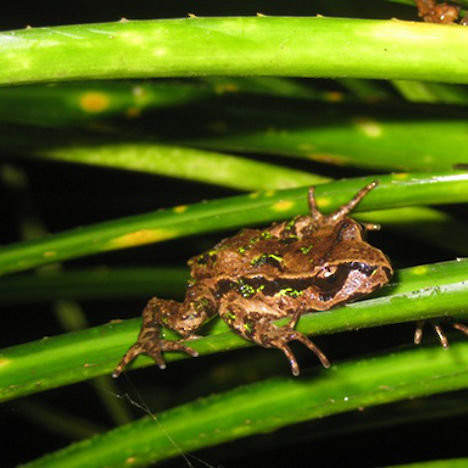Threat category:
Threatened: Nationally Vulnerable?Regions:
WaikatoDistribution:
Coromandel Peninsula and western King Country
Description
- Small (<50 mm long) green-brown frogs with very large eyes; nocturnal.
- Archey’s frogs lack webbing between the toes.
Interesting Facts
- Populations of Archey’s frog have crashed in recent years with monitored populations decreasing by 88% over between 1996-2001. It is likely that this decline has been due primarily to the recently introduced disease chytridiomycosis which is affecting frog populations worldwide.
- Otago University researchers have developed a cure for the Chytrid fungus in the laboratory and are continuing their research.
- Long-term studies carried out by Victoria University researchers are some of the longest studies of frogs in the world. These studies have shown that New Zealand’s native frogs are very long-lived: two Archeys frogs are at least 27 years old.
- New Zealand’s native frogs are some of the most primitive frogs in the world. They lack free ribs (i.e. ribs are not fused to vertebrae), they lack external eardrums, and there is no tadpole stage - the eggs hatch directly into frogs.
- Archey’s frogs inhabit the floor of indigenous forests, generally between 400-1000m asl, and Hochstetter’s frogs inhabit stream verges in indigenous forests.
- Both species shelter beneath logs and rocks during the day and emerge to feed on invertebrates at night.
- Internationally, many species of frog have declined rapidly, usually from unknown causes.
Association with Plantations
- Archey’s frogs have been found within plantations and associated indigenous remnants in the Coromandel and King Country.
Threats
- Indigenous forest loss from land development.
- Sedimentation and loss of habitat as a result of severe storms.
- Introduced mammals (goats, cattle and pigs) can modify habitat through destruction of riparian vegetation and by accelerating siltation.
- The role, if any, of introduced predators is unknown, but the persistence of these two frog species in the presence of a large predator suite suggests that predation may not be a significant problem.
- Chytrid fungus, which has recently been detected in New Zealand frog populations.
- The role of pesticides and herbicides in the decline of frog species worldwide and within New Zealand is a hotly debated issue. Glyphosate (e.g. Roundup) has been shown to cause extremely high mortality of tadpoles and frogs in field situations (e.g Relyea 2005) although some scientific papers have shown minimal effects. Others have indicated that the most damaging component is the surfactant mixed with the glyphosate. Atrazine has been blamed for chemical castration of frogs. A growing number of scientific papers which investigate the effects of various chemicals on amphibians is available.
Management Options and Methods
- Maintain wide zones of riparian vegetation streams where frogs are known to occur.
- Consider permanent protection of known frog habitat.
- Comply with best forest operational management practices to avoid damage to riparian areas and frog habitat.
- It is particularly important to fell and haul timber away from stream beds.
- Avoid damage to wet seeps and streams in areas known to contain frogs.
- Maintain shade vegetation around wet seeps and streams in areas known to contain frogs.
- Maintain wide buffers to frog habitat.
- Exclude livestock from known frog habitat.
- Control deer and goats that could enter frog habitat.
- Prior to survey, spray boots with “Virkon”, a viruncidal disinfectant, to combat spread of Chytrid.
- Do not shift any frogs as this may lead to the spread of disease.
- Consider the need for the use of herbicides in the vicinity of waterways and riparian margins, particularly if native frog populations are known to be present in the area.
- Any use of pesticides and herbicides in areas supporting native frog populations should be carried out with advice from either DOC or university experts.
- Raise awareness of staff and contractors of the presence of frogs and the need to protect them.
Monitoring Options
- Survey sites of potential frog habitat, particularly if first time planting is being considered for the general area.
- Maintain database of sightings and liaise with DOC.
- A low-intensity monitoring technique has been developed for Hochstetter’s frog (Crossland et al. 2005) which may be suitable for Archey’s frog.
- Further frog monitoring techniques are currently being developed by DOC.
- Report findings to DOC.
Further Information and Support
- Department of Conservation website.
- Bishop et al. 2013. Native frog (Leiopelma species) recovery plan, 2013-2018. Threatened Species Recovery Plan No. 63. Department of Conservation.
- Crossland et al. 2005. Assessment of site-occupancy modeling as a technique to monitor Hochstetter’s frog (Leiopelma hochstetteri) populations. DOC Research and Development Series 218.
- The New Zealand frog website http://www.nzfrogs.org/. Gives names and locations of experts in the fields of New Zealand native frog research.
- Relyea 2005. The lethal impact of Roundup on aquatic and terrestrial amphibians. Ecological Applications vol. 15.


